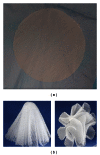Characterization of the Mechanical Strength, Resorption Properties, and Histologic Characteristics of a Fully Absorbable Material (Poly-4-hydroxybutyrate-PHASIX Mesh) in a Porcine Model of Hernia Repair
- PMID: 23781348
- PMCID: PMC3679684
- DOI: 10.1155/2013/238067
Characterization of the Mechanical Strength, Resorption Properties, and Histologic Characteristics of a Fully Absorbable Material (Poly-4-hydroxybutyrate-PHASIX Mesh) in a Porcine Model of Hernia Repair
Abstract
Purpose. Poly-4-hydroxybutyrate (P4HB) is a naturally derived, absorbable polymer. P4HB has been manufactured into PHASIX Mesh and P4HB Plug designs for soft tissue repair. The objective of this study was to evaluate mechanical strength, resorption properties, and histologic characteristics in a porcine model. Methods. Bilateral defects were created in the abdominal wall of n = 20 Yucatan minipigs and repaired in a bridged fashion with PHASIX Mesh or P4HB Plug fixated with SorbaFix or permanent suture, respectively. Mechanical strength, resorption properties, and histologic characteristics were evaluated at 6, 12, 26, and 52 weeks (n = 5 each). Results. PHASIX Mesh and P4HB Plug repairs exhibited similar burst strength, stiffness, and molecular weight at all time points, with no significant differences detected between the two devices (P > 0.05). PHASIX Mesh and P4HB Plug repairs also demonstrated significantly greater burst strength and stiffness than native abdominal wall at all time points (P < 0.05), and material resorption increased significantly over time (P < 0.001). Inflammatory infiltrates were mononuclear, and both devices exhibited mild to moderate granulation tissue/vascularization. Conclusions. PHASIX Mesh and P4HB Plug demonstrated significant mechanical strength compared to native abdominal wall, despite significant material resorption over time. Histological assessment revealed a comparable mild inflammatory response and mild to moderate granulation tissue/vascularization.
Figures





References
-
- Deeken CR, Eliason BJ, Pichert MD, Grant SA, Frisella MM, Matthews BD. Differentiation of biologic scaffold materials through physiomechanical, thermal, and enzymatic degradation techniques. Annals of Surgery. 2012;255(3):595–604. - PubMed
-
- Breuing KH, Colwell AS. Inferolateral AlloDerm hammock for implant coverage in breast reconstruction. Annals of Plastic Surgery. 2007;59(3):250–255. - PubMed
-
- Assalia A, Ueda K, Matteotti R, Cuenca-Abente F, Rogula T, Gagner M. Staple-line reinforcement with bovine pericardium in laparoscopic sleeve gastrectomy: experimental comparative study in pigs. Obesity Surgery. 2007;17(2):222–228. - PubMed
-
- Cook JL, Fox DB, Kuroki K, Jayo M, De Deyne PG. In vitro and in vivo comparison of five biomaterials used for orthopedic soft tissue augmentation. American Journal of Veterinary Research. 2008;69(1):148–156. - PubMed
-
- Franklin ME, Treviño JM, Portillo G, Vela I, Glass JL, González JJ. The use of porcine small intestinal submucosa as a prosthetic material for laparoscopic hernia repair in infected and potentially contaminated fields: Long-term follow-up. Surgical Endoscopy and Other Interventional Techniques. 2008;22(9):1941–1946. - PubMed
LinkOut - more resources
Full Text Sources
Other Literature Sources
Medical
Miscellaneous
